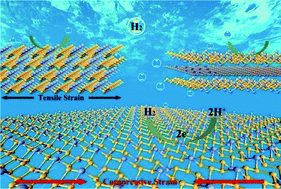Applying surface strain and coupling with pure or N/B-doped graphene to successfully achieve high HER catalytic activity in 2D layered SnP3-based nanomaterials: a first-principles investigation†
Abstract
Based on DFT computations, we have systematically investigated the catalytic activity for the hydrogen evolution reaction (HER) on two-dimensional (2D) layered SnP3-based systems. It is found that the monolayer SnP3 nanostructure can exhibit good HER activity, where the P atom with a near-zero ΔGH* value serves as the most active site. Comparatively, few-layered SnP3 nanostructures can possess relatively weak HER activity. Furthermore, application of compressive strain on monolayer 1L-SnP3 and tensile strain on few-layered nL-SnP3 (n ≥ 2) systems can endow all these 2D layered nanostructures with higher HER activity, by optimizing the adsorption state of H* and conductivity simultaneously. Moreover, a series of new 2D bilayer and sandwich nanostructures nL-SnP3/G have been constructed by alternately stacking the monolayer SnP3 and graphene. Regardless of the layer number, all of them can uniformly exhibit higher HER catalytic activity than the monolayer, in view of the optimized ΔGH* values and good conductivity. The HER catalytic activities of these 2D composite systems can be further enhanced by doping N or B atoms into the graphene subunit, with B-doping being superior to N-doping. In addition, all the correlative catalytic mechanisms are also analyzed in detail. Clearly, coupling with the high structural stability and good conductivity, all these 2D layered SnP3-based nanomaterials can be very promising candidates as highly efficient and nonprecious HER electrocatalysts.



 Please wait while we load your content...
Please wait while we load your content...